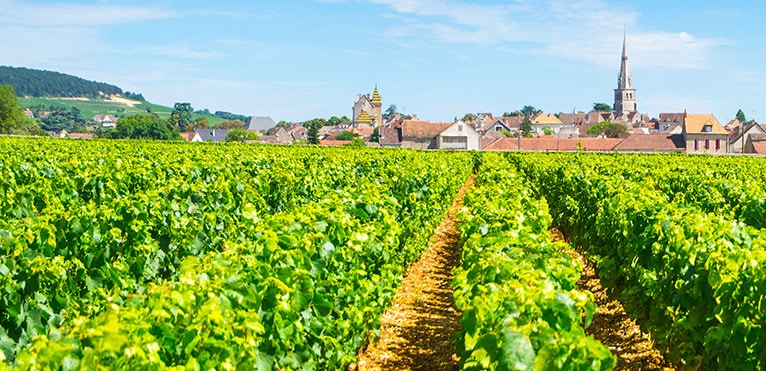
Contents
Meursault is one of the 84 wine appellations in the Burgundy region. The village of Meursault is located in the heart of the Côte de Beaune in the Côte d’Or department, Burgundy. The wines of this appellation are essentially white. They account for 96% of production, compared with just 4% for red wines. It is recognized by the French AOC (Appellation d’Origine Contrôlée) label.
The Meursault terroir is located in the heart of Burgundy
Although traces of wine production can be traced back to ancient times and throughout the Middle Ages in the commune of Meursault, the vineyard experienced real growth from the 12th century onwards, in parallel with the development of trade in the town of Beaune, just 8 kilometers from the village.
In the 17th century, the vineyards were in dire straits. Red wine is becoming more popular, and consumers are moving away from white wine, which accounts for almost all of the vineyard’s production. Meursault has also been hit hard by vine diseases, notably mildew and phylloxera. This period marked a structural turning point for the vineyard.
In difficulty after the First World War, wine production was bolstered by the creation of the “Meursault” Appellation d’Origine Contrôlée in 1937. The AOC includes 19 lieux-dits classified as premier cru, the best-known of which are : Les Caillerets, Charmes, Clos Les Perrières and Genevrières.
The Meursault vineyards are characteristic of the region
Situated between the communes of Volnay and Puligny-Montrachet, which have also lent their names to AOC appellations, the Meursault vineyard covers 395 hectares. The south-east-facing slopes, at an altitude of between 230 and 360 metres, are crossed by the Clous stream. The vines draw their resources from a soil composed of alternating marl and limestone. The subsoils are all limestone, but have a wide range of porosity, which explains the numerous faults that shape the terrain. The nature of the soils varies little within the different parcels that make up the appellation. The Premier Crus are all situated between 260 and 280 meters above sea level, i.e. mid-slope.
Meursault reveals its terroir by the glass
The winegrowing region is particularly focused on the production of white wines, made from the Chardonnay grape variety. The few red wines produced within the appellation are made from Pinot Noir grapes. In its early years, Meursault wine is pale gold in color, with a hint of green. Its first nose reveals a floral dimension, with aromas of lime blossom and hawthorn. After tasting, we discover more varied evolutions, revealing memories of butter, honey and citrus. On the palate, the wine seduces us with its combination of fatness and acidity, joined by aromas of dried fruit and revealing the minerality of the terroir. Meursault wines have an ageing potential of 10 to 12 years for white wines. Red wines have a shorter shelf-life, ranging from 5 to 8 years.
Meursault is the ideal wine to enhance your finest dishes
Thanks to its profile combining fatness, acidity and minerality, Meursault white goes well with many culinary specialties. Serve with fish, poultry and cheese. It goes perfectly with fish in sauce, Bresse poultry, salmon in cream sauce, and fatty cow’s milk cheese with washed rind.
Meursault white wine is best served slightly chilled, between 11 and 12°C. Red wine is best enjoyed at a slightly warmer temperature, between 16 and 17°C.
Exceptional vintages of AOC Meursault
Each year, the region’s climatic conditions vary, giving certain vintages a remarkable exceptionality. For the Meursault appellation, the vintages of the last millennium were 1928, 1929 and 1969. In recent decades, there have also been some exceptional vintages. The most recent date from 1990 and 2005, and are just as distinctive.
Historic Meursault estates
Maison Joseph Drouhin
This Meursault vineyard is one of the largest and oldest in the region. Established in Burgundy 140 years ago, the Drouhin family belongs to the very select circle of Primum Familiæ Vini (First Families of Wine), numbering just twelve members worldwide. Joseph Drouhin, the current descendant of four generations of Drouhins, cultivates an 80-hectare vineyard of around 90 appellations organically and biodynamically. The domaine covers the whole of Burgundy: Chablis, Côte de Nuits, Côte de Beaune, Meursault and Côte Chalonnaise, offering a varied palette of terroir and aromas to the estate’s crus. Planted exclusively with Pinot Noir and Chardonnay grapes, the vineyard comprises a majority of Grands Crus and Premiers Crus. The estate’s wine labels feature the names of particularly famous parcels, such as Clos des Mouches, Clos de Vougeot and Corton-Charlemagne.
Henri Darnat Estate
With the vast majority of their vines planted with Chardonnay, accompanied by a few parcels of Pinot Noir, Henri and Marion Darnat produce mineral, floral wines that are typical of Burgundy vineyards. The couple continue the estate’s tradition, which has been in the family since the mid-19th century, and took over the reins of the vineyard in 2000. The 17.5 hectares of vines are cultivated by hand, without chemical additives and with respect for the environment. It’s this respect for the terroir and its diversity that gives the estate’s vintages such delicious aromas.